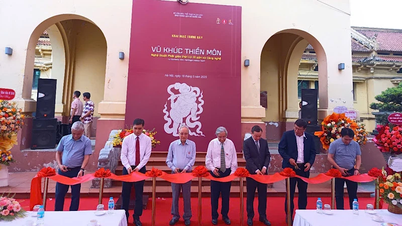Nghe An Museum, in collaboration with the University of Social Sciences and Humanities (Vietnam National University, Hanoi), and international experts from the Department of Archaeology and Anthropology, Australian National University, conducted an archaeological excavation at the Quynh Van site, village 6, Quynh Van commune, Quynh Luu district, Nghe An province.
 |
Artifacts found underground at a depth of more than 3m |
After more than a month of excavation, archaeologists excavated 2 pits with an area of 18 square meters, initially discovering many stone and bone artifacts such as axes, flakes, pestles, stoves...
In particular, at excavation pit No. 2, archaeologists initially discovered 9 sets of remains of Quynh Van culture residents lying 3m below ground level. These remains were mostly buried in the typical kneeling posture of Quynh Van culture and were distributed relatively densely, each remains only about 50cm apart.
Among them, there are 3 remains stacked on top of each other and separated by a thin layer of soil, surrounded by layers of mollusk shells. Some burials discovered jewelry made of seashells and snail shells.
 |
Some artifacts found during mining |
According to experts, after the excavation, all the remains and artifacts will be tested using C14 radiation to determine the exact age and conduct further research on the life of ancient residents. The results are expected to be announced in the near future.
Quynh Van culture belongs to the late Neolithic period, starting about 6,000 years ago and ending about 4,000 years ago, distributed mainly in the coastal plains of Nghe An and Ha Tinh ; belongs to the type of scallop sandbar relics, 5 to 6m thick, large area, about 1 to 10km from the sea.
The Quynh Van culture was first discovered by French scholars in the 1930s in the Cau Giat area.
Through many surveys and excavations in 1963, 1976 and 1979, 21 sites related to this culture were identified, mostly concentrated in Quynh Luu district.
Traces of habitation including kitchens, earthen pits, burials, stone tools, bone objects, pottery shards and many mollusk shells show a lifestyle closely linked to the sea and hunting and gathering activities of prehistoric residents.
The collected artifacts will be preserved and displayed at Nghe An Museum, adding valuable resources to serve the work ofeducation , research and promotion of local cultural heritage.
Source: https://baophapluat.vn/phat-hien-9-bo-hai-cot-an-tang-theo-tu-the-ngoi-bo-goi-duoi-long-dat-tai-quynh-van-post546273.html



![[Photo] Prime Minister Pham Minh Chinh and Prime Minister of the Kingdom of Thailand Paetongtarn Shinawatra attend the Vietnam-Thailand Business Forum 2025](https://vphoto.vietnam.vn/thumb/1200x675/vietnam/resource/IMAGE/2025/5/16/1cdfce54d25c48a68ae6fb9204f2171a)





![[Photo] Many people and tourists come to the photo exhibition "Bright Name of the Person"](https://vphoto.vietnam.vn/thumb/402x226/vietnam/resource/IMAGE/2025/5/16/de2c8ad0828f4883bbdeb4f84a074a05)

















![[Photo] President Luong Cuong receives Prime Minister of the Kingdom of Thailand Paetongtarn Shinawatra](https://vphoto.vietnam.vn/thumb/1200x675/vietnam/resource/IMAGE/2025/5/16/52c73b27198a4e12bd6a903d1c218846)































































Comment (0)